PRECIS
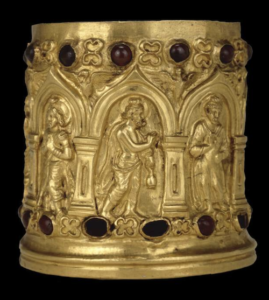
The Bimaran Reliquary, cylindrical in shape; made of gold and inset with garnets, Gandhara School, Darunta, Afghanistan, Excavated by Charles Masson, 1833-8. © Trustees of the British Museum
Afghanistan’s Taliban take the position today that preserving cultural heritage is a good thing, especially if someone else is willing to pay for it. Not that the Taliban have agreed to any long-term program to address cultural heritage at risk throughout Afghanistan. Instead, the Taliban have allowed a few conservation projects established under the prior Ghani government to continue with funding from the Swiss ALIPH foundation and the Aga Khan Trust for Culture. They have also undertaken to “restore” a few crumbling buildings or sites that will facilitate economic development. But as far as heritage ‘policy’ goes, the Taliban’s public pronouncements have been made by officials distant from its extremist center. The Taliban government remains characterized by zero-transparency and zero-accountability, and the habit of turning from one policy to another on a dime.
For all their bargaining over methods of copper extraction at Mes Aynak, the Taliban remain on extremely good terms with their prospective partners, Chinese mining companies. In Mes Aynak, an 18-month program to shore up protective barriers will facilitate removal of some of the most precious remains to Kabul; it will not protect the integrity of the 100-acre site as a whole. In Bamiyan, Taliban-imposed prohibitions against unauthorized digging, building and road construction and other development that threatens the cliffs and wallpaintings are not being enforced by local Taliban officials.
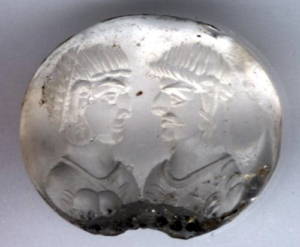
Oval intaglio in rock crystal showing the busts of a man and woman facing each other, Hunnish, 5thC-6thC, Afghanistan, Probably purchased by Charles Masson in Kabul bazaar, 1833-8. © Trustees of the British Museum
However, by portraying themselves as suddenly caring about Afghanistan’s rich Buddhist and early Islamic heritage, the Taliban are following a path to international legitimacy pioneered by members of the Khmer Rouge in the 1980s, who in Paris exile, presented themselves to UNESCO as the future preservers of Angkor Wat, hoping to gloss over the memory of the ‘Killing Fields.’
All work to preserve ancient heritage should be applauded, but the fact is, the Taliban cannot be trusted. So far, their conservation activities are gestures rather than commitments. Though welcome, they stand in stark contrast to the Taliban’s rigid authoritarian rule, their murderous brutality when crossed, and their denial of basic human rights – much less cultural rights – to fully one-half of the population of Afghanistan, its women and girls.
Conservation and Preservation in Afghanistan
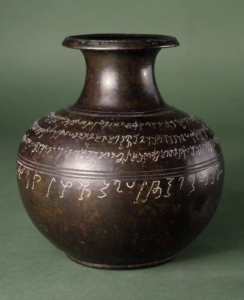
The Wardak Reliquary Vase, Gandhara School, Buddhist, Afghanistan. Excavated by Charles Masson. An inscription in Kharoshthi in four lines is dated in the Kushan year 51. Mahāsāṃghika sect inscription dedicates a relic of the Buddha in a stupa at Khavada, modern Wardak, Wardak district, near Kabul. Charles Masson: Collections from Begram and Kabul Bazaar, Afghanistan 1833-1838 © Trustees of the British Museum
The image above of 85 Afghan workers seated around a beautifully excavated Buddhist stupa near Kabul, one in the middle giving a thumbs-up, is immensely heartwarming. The partial restoration and stabilization of the 1st-3rd C CE Shewaki stupa was the result of a positive collaboration between funder, the International Alliance for the Protection of Heritage in Conflict Areas[1] (ALIPH), local operator, the Afghan Cultural Heritage Consulting Organisation (ACHCO), and eventually, the Taliban, after they took Kabul in August 2021.
As the photo of workers on the stupa makes clear, the Shewaki site excavation and restoration significantly bettered the employment situation for local villagers. Preliminary investigations show that there is much more archaeological work to be done in the area surrounding the site. The only funding available is what is contributed by foreign foundations and international NGOs, and already stretched resources are being used elsewhere in Afghanistan for equally urgent projects.
The Aga Khan Trust for Culture and Aga Khan Development Network (now engaged for more than 20 years in Afghanistan), ALIPH, and UNESCO have all engaged in projects in Afghanistan with the dual intention of preserving endangered heritage and providing employment and training to Afghans. In the case of the excavation and conservation of the Shewaki stupa, work was almost completed prior to the Taliban takeover. The Taliban are willing to let restoration projects go forward – for now. A collaboration has just been announced with Italy and UNESCO for the preservation of the cliffs of Bamiyan, where the Taliban in 2001 destroyed the giant Buddhas that had stood for 1500 years.
There are good reasons for the Taliban to cooperate in cultural heritage projects. Heritage projects are undeniably beneficial to local employment and effective in the short term in preserving selective monuments. Heritage projects bring in international funding, although limited, to Afghanistan. Any infusion of money is a positive for the Taliban, given the restrictions of international[2] sanctions and the U.S.[3] freezing of Afghanistan’s government assets. And it’s not the Taliban’s money that is being spent, after all.
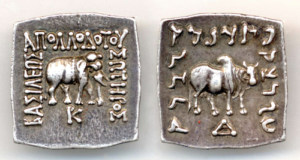
Silver coin of ruler Apollodotus I, Elephant standing to right. Humped bull walking to right. Kharoshthi and Greek inscriptions. Greco-Bactrian, 180 BC-170 BC, Minted in Afghanistan. Charles Masson: Collections from Begram and Kabul Bazaar, Afghanistan 1833-1838 © Trustees of the British Museum
Future Taliban policies on the preservation of heritage are more likely to be driven by larger economic issues, such as mining interests. Rich mineral resources are often located in proximity to sites that flourished in ancient times by mining and trading in metals. The extraordinary copper resources of Mes Aynak are only the best-known example.[4] The true ‘looting’ that has taken place in Afghanistan in the last 25 years was by powerful individuals who ‘stole’ its mineral riches and paid no extraction fees or royalties to the government[5] – and by the Taliban itself. In the five years prior to taking Kabul, the Taliban controlled most of the mineral-rich regions in Afghanistan and were earning $400 million per year from illegal mining, a figure confirmed by independent researchers.[6] Now the Taliban government is directing Afghanistan’s mineral exploitation. Mining is a business the Taliban understand well, and wherever the choice is between exploiting mineral wealth or preserving ancient heritage, the first is likely to win out.
Other reasons for the Taliban’s sometimes grudging support of conservation work are diplomatic. Heritage projects shine a rare positive light on a government that is run by terrorists, which is actively working to destroy the remnants of modern civil society, and which denies Afghans citizens, especially women and girls, every human right.[7]

Octagonal amulet box, made of gold and inset with garnets. Gandhara School, Kushan, 2ndC-3rdC, Found/Acquired: Ahin Posh, Afghanistan, Charles Masson: Collections from Begram and Kabul Bazaar, Afghanistan 1833-1838 © Trustees of the British Museum
The Taliban have clearly grasped the usefulness of embracing cultural heritage preservation as the first step in the path to diplomatic legitimacy. Western journalists who take curated journeys to sites that the Taliban claim they want to preserve should be skeptical of their assurances. There may be some Taliban who sincerely appreciate ancient heritage and even humanist values – but that has never been its leadership’s perspective. It’s worth remembering how the Khmer Rouge in exile used ‘heritage’ as their entre to international recognition and campaigned for a ‘neutral’ Angkor Wat at UNESCO in order to build political credibility and distance themselves from the horrors of the Killing Fields.[8] True, Angkor Wat has been preserved, but it now used as a key propaganda tool by the ex-Khmer Rouge officer and now Cambodian prime-minister for life, Hun Sen, to bolster his efforts to dilute the influence of the royal family and establish a new dynasty with his son as heir. The international nonprofits working to preserve heritage in Afghanistan are certainly aware that there are serious questions about whose interests they may ultimately be serving.
Trusting the Taliban on matters of heritage is also chancy because their policies are often wildly inconsistent and changeable. The Taliban have a history of making promises and then reneging. Announcements made by the more visible government players in Kabul are often disapproved of and overturned by more conservative leaders in Afghanistan’s south.
However, with whatever grain of salt the Taliban’s pronouncements should be taken, any efforts towards preservation today should be welcomed. Here are some of the projects ongoing or recently completed in Afghanistan.
BUDDHIST STUPA AT SHEWAKI 2016-2022
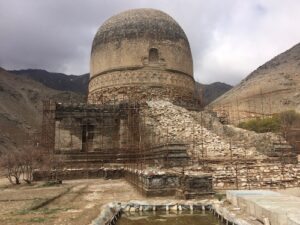
Topdara stupa under reconstruction, Shewaki Afghanistan, courtesy ALIPH.
In 2020, the ALIPH Foundation donated over $800K to complete the restoration of a Buddhist stupa at Shewaki not far from Kabul. ALIPH worked with a local organization, the Afghan Cultural Heritage Consulting Organisation (ACHCO) that had begun restoration work on the stupa in 2016, five years before the Taliban takeover in August 2021. By 2019, the ACHCO, in collaboration with the Ministry of Information and Culture and the Afghan Institute of Archaeology, had excavated almost the entire base of the stupa and repaired most of the drum. The stupa had originally been described by Charles Masson, an English deserter and explorer (and early archaeologist) hired by the British East India Company to document sites in Afghanistan between 1832-1835.[9] Two tall, ceremonial stairs led from a wide base, originally decorated with pilasters and with some remaining pavers, up to the square base of the drum, allowing ritual circumambulation of the stupa. Now, with the excavation and restoration of the remaining platforms surrounding the stupa near completion, the monument has striking presence and the community that has worked on it can take great pride in being part of its restoration. Unfortunately, while the area near to the stupa appears also to be rich in archaeological finds, funding to do more excavation is lacking.
BALA HISSAR, KABUL 2021-2024
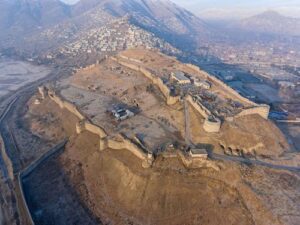
Bala Hissar, aerial view. Courtesy Aga Khan Trust for Culture.
Another conservation project begun prior to the Taliban takeover was the restoration of the Bala Hissar, an historic citadel overlooking Kabul.[10] The ancient fort was still being used by the Afghan military until 2018. It had suffered considerable damage during the first Soviet-backed coup d’etat in 1978, the Soviet invasion in 1979 and subsequent chronic fighting in the region.
The project to transform the site into a full-fledged archaeological park was announced in October 2020 under the Ghani government, with partners the ALIPH Foundation, the Aga Khan Trust for Culture (AKTC), the Government of Afghanistan and the Délégation Archéologique Française au Afghanistan (DAFA). The Government of India pledged $1 million for the Bala Hissar project in 2020, but after the Taliban takeover, India went silent, leaving the project in limbo and solely in the hands of the AKTC.[11]
In March 2021, ALIPH announced that it would provide $2.6 million in funding to the Afghan government, the AKTC, and DAFA in order to revive the project. DAFA also announced discoveries of Kushan and early Islamic finds at the site.[12] Then the withdrawal of the U.S. and capture of Kabul by the Taliban in August 2021 again put the project on hold. It is unclear how much work is going on at the site today, although the ALIPH website reflects a funding commitment through 2024.
STABILIZATION OF THE MUSALLA COMPLEX’S 5TH MINARET, HERAT 2023-2024

Gawar Shad Mausoleum, Herat, Photo Sven Dirks, 6/27/ 2004, CCA -SA 3.0.
The Timurid period Musalla complex in Herat, commissioned by Gawar Shad, the wife of the ruler Shah Rukh, was considered one of the great masterpieces of Islamic architecture. It covered a vast area and included three major buildings and ten minarets. What remains today are only the Mausoleum of Gawar Shad, with a beautiful, ribbed dome, the much smaller mausoleum of the poet Mir Ali Shir Navai, and five minarets that once flanked other buildings, which are now destroyed. The fifth minaret is thought to be one remaining of a pair that flanked the entrance of the Medresse of Gawar Shad. Flooding, Afghanistan’s frequent earthquakes, and environmental changes have caused this minaret to tip more than two degrees and threaten its collapse. The ALIPH Foundation has partnered with the Aga Khan Cultural Services – Afghanistan (to perform on-the-ground services to do emergency stabilization and structural consolidation of the fifth minaret.
BAMIYAN VALLEY AND SHAR I GHOLGHOLA
The Bamiyan Valley, the central Afghanistan site where the Taliban blew up two giant, ancient Buddhas carved into its cliffs in 2001 (and UNESCO listed the site as World Heritage in Danger in 2003), is the most famous in ancient locale in Afghanistan; dozens of conservation projects have taken place there over time.
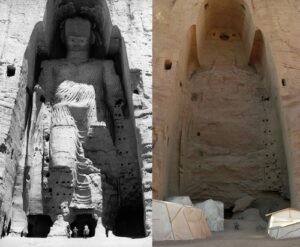 The prognosis for Bamiyan was not good. The most recent (2021) UNESCO report on Bamiyan reiterates past concerns: commercial development close to the site, cracks in the cliff caused by the explosions more than 20 years ago which have since filled with expanding ice each winter, placing the Giant Buddha niches at risk of collapse, and irreversible deterioration of the mural paintings that decorate the niches and dozens of adjacent caves.[13] In March 2022, Ghulam Reza Mohammedi, the former UNESCO coordinator for Bamiyan stated that, “What remains in Bamiyan, the niches and the cliff, will collapse in the next ten years if the current mismanagement, unplanned excavations and disorder continues. It is a very realistic view and we should not fool ourselves otherwise.”[14]
The prognosis for Bamiyan was not good. The most recent (2021) UNESCO report on Bamiyan reiterates past concerns: commercial development close to the site, cracks in the cliff caused by the explosions more than 20 years ago which have since filled with expanding ice each winter, placing the Giant Buddha niches at risk of collapse, and irreversible deterioration of the mural paintings that decorate the niches and dozens of adjacent caves.[13] In March 2022, Ghulam Reza Mohammedi, the former UNESCO coordinator for Bamiyan stated that, “What remains in Bamiyan, the niches and the cliff, will collapse in the next ten years if the current mismanagement, unplanned excavations and disorder continues. It is a very realistic view and we should not fool ourselves otherwise.”[14]
Even local Taliban in Bamiyan seemed to agree. Mawlawi Saifurrahman Mohammadi, Bamiyan’s director for information and culture, stated in November 2022 that, “If conservation work is not carried out in Shahr-e Gholghola within a year the whole site can be affected and destroyed. The issues will become much larger.”[15]
A few months later, in September 2022, Jolyon Leslie, an advisor to the Afghan Cultural Heritage Consulting Organisation reminded the Art Newspaper that UNESCO had worked for decades on a series of ‘master plans’ “with little idea of how these might actually be realized,” while illegal development had gone on for decades.[16]

The Hunter King from Kakrak, a valley next to Bamiyan. Wall paintings from the 7th-8th century, Kabul Museum, Afghanistan.
Meanwhile, damage continued unchecked. A coal depot had been built at the base of the niches where the 55m and 38m tall statues had stood, and heavy trucks lumbered past to dump and pick up loads. After the local Taliban governor was pressured into halting the coal business a new bazaar was scheduled to be built right within the area that should have buffered the cliff remains. Again pressured by objections from international organizations working in Afghanistan, construction of the bazaar was halted.
After a November 2022 conference organized by Florence University and the Italian Agency for Development Cooperation, the Italian foreign ministry agreed to reconsider funding for conservation work at Bamiyan and the citadel of Shar-i-Gholghola (the City of Cries, abandoned in 1221 after their inhabitants were slaughtered by the invading Mongols). In February 2023, the Italian government gave approval to restart projects that were placed on hold after the Taliban takeover, to improve safety, develop (yet another) conservation management plan, and incidentally, to encourage tourism.
Just a year ago, Ishaq Mowahidi, formerly chief of Bamiyan’s Ministry of Information and Culture told the Art Newspaper that, “The Taliban claim they are different from 20 years ago, but their negligence in looking after these sites shows that they have not changed at all. This shows they are still unwise and against humanity.” [17]
For the sake of history and the future of the mostly Shia Hazara inhabitants of Bamiyan and its surrounds, who have faced extreme discrimination by the Taliban, it is hoped that the Italian project will succeed in protecting some of what remains.
See also: Bamiyan: What Lasted for 1500 Years Will be Gone in Ten, CPN, March 11, 2022.
MINARET OF JAM

Minaret of Jam, Harirud, Afghanistan, Photo by David Adamec, 2006, public domain.
The Minaret of Jam, a World Heritage Monument of extraordinary epigraphic skill and beauty, was built by the Ghorid Sultan Ghiyas-ud-din in 1194. The minaret is 65 meters tall and made of fired bricks, many with remaining colored tilework decoration. It lies in an otherwise desolate steep walled river-cut defile in west-central Afghanistan that is thought to have been a summer retreat for the Sultan’s court, the ancient city of Firuzkuh. Its remote location, far from any town on the banks of the Hari-Rud has played some part in it relatively high state of preservation. It has never been extensively restored – only the most basic work has been done to protect its foundations from erosion. Inscribed stones that appear to mark a Jewish cemetery of the same date are found near the minaret as are fragmentary remains of other Ghorid period buildings. UNESCO, which is currently working with local contractors in Jam, is currently seeking cooperation with the Afghan Ministry of Culture to do more to protect the site of the minaret by setting out a buffer zone and adding to basic erosion prevention and stabilization.
MES AYNAK BUDDHIST COMPLEX
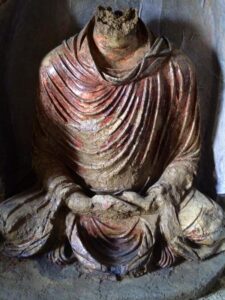
Mes Aynak. Figure of seated Buddha with head removed or destroyed. Credit Brent Huffman, www.Saving Mes Aynak.com
The discovery of Mes Anak, a 100 acre ancient Buddhist site in the mountains near Kabul, has raised greater controversy than any other site. This vast Buddhist complex sits atop one of the world’s richest sources of copper. The Taliban say they wish to preserve the ancient site, but also that they want to access the rich copper ores that lie beneath it by tunneling beneath the site, leaving the surface undisturbed. The Chinese mining companies insist that the only viable way to extract the copper is through a giant pit mine that would completely destroy the Buddhist site and the earlier sites that preliminary excavations show lie deeper beneath the surface. While some statues and smaller finds have been able to be removed after excavation, many larger Buddhist sculptures and stupas are constructed of brick covered with plaster and paint or gold leaf. They are thought to be too fragile to be safely moved.
The mining effort was stalled for years by prolonged negotiations between the Chinese and the U.S. supported Afghan government and by attacks on the imported Chinese workers at the site by insurgent Taliban. A heartbreaking and well-researched documentary film, Saving Mes Aynak,[18] which focused on the work of dedicated Afghan archaeologists, generated international outrage at the loss to human heritage the mining would cause. So far, the site has been spared destruction.
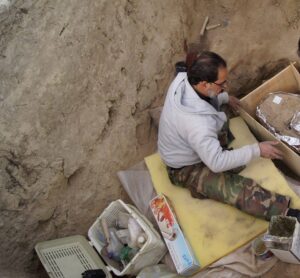
Archaeologist Abdul Wahab Ferozi, killed by the Taliban in a bomb blast in 2018. Credit www.Saving Mes Aynak.com
The Taliban stated recently that they would allow a year and a half long conservation project to rebuild more solid shelters over the exposed Buddhist statues and stupas at Mes Aynak that were collapsing after years of exposure and heavy snow. It is hoped that this will facilitate the removal of additional artifacts from the site to take them to the Kabul Museum. The project is funded with $1 million from ALIPH and the on-site work is being coordinated by the Aga Khan Trust for Culture. The AKTC is bringing in 350 workers to work to protect some 50 sites in the 100 acre complex.
However hopeful this sounds, it must be remembered that the primary driver of Taliban actions on Mes Aynak is their desire to negotiate the best deal for its mineral wealth. Prior to taking power, the Taliban derived most of their funding from illegal mining. Their first outreach to foreign governments after the capture of Kabul was to send representatives to China to discuss mining Mes Aynak, and the Chinese were the first to visit Kabul. Ajmal Maiwandi, who heads the AKTC in Afghanistan, made these concerns clear: “When the conservation plan is in place we are going to consolidate as many of the artefacts as possible in the year that we have left…” because “without knowing exactly when mining operations could begin, we need to act fast.”
THE YU AW SYNAGOGUE IN HERAT
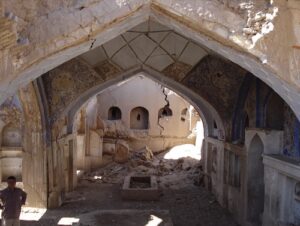
Yu Aw synagogue in Gerat, Afghanistan in 2007, prior to restoration. Image courtesy ACHO.
The “target” for conservation in Afghanistan is puzzling in this case. This project, to restore the late 19th– early 20th C Yu Aw synagogue in Herat to turn it into a community museum (though its Wikipedia page states it serves as a child care center) and the neighboring Jewish bathhouse as a local hammam may be useful to the present Herati community, but not to its former Jewish community owners, especially since there is not a single Afghan Jew remaining in Afghanistan. Afghanistan’s Jewish community, which had lived their for millennia, departed as refugees after the Soviet invasion and the civil war that followed, abandoning their property. Zalmay Safa, who served as historic preservation officer both for the Ghani government and the Taliban told the Art Newspaper that, “This is a cultural and historic site, which is not used as a place of worship, and the local government will support its preservation. Despite the change in government our historic sites remain protected and they are not in any way connected to religious matters.” His intent, he said, was to be tolerant and respectful of others places in Afghanistan’s history. He may not be aware of the sensitivities of the Jewish community in the diaspora to the repurposing of synagogues for non-Jewish purposes.
Middle Eastern and North African nations that drove out their millennia-old Jewish communities in the 20th century have followed a regular pattern of turning synagogues into either mosques or secular community centers, as well as bulldozing or smashing tombs in Jewish cemeteries. When undertaken without the agreement of the displaced Jewish communities, such “restorations” have often sparked protests.
FINAL NOTE

Reliquary, schist, 1stC (late)-2nd C (found with coins of Kujula Kadphises (c. AD 40-90), Excavated by Charles Masson, Kotpur Stupa 2, Afghanistan, found by Charles Masson, 1833-8. © Trustees of the British Museum
The need for continuing archaeological work in Afghanistan is plain. The economic benefits to ordinary Afghans in the often remote areas where sites are located is also clear. There is no question of the commitment and dedication of Afghanistan’s archaeological and cultural heritage specialists. But the fact that such work is tolerated by the Taliban means only that it is now useful to them, and may easily be superseded by other interests.
Whether the Taliban will ever conform to a true humanist perspective on the country’s rich and diverse history, whether they will ever themselves adopt policies promoting preservation, conservation, public access and uncensored scholarly study of the material culture of Afghanistan – this question has not been and is unlikely to be answered in the near future except with a negative. It seems more likely that art and heritage will be treated by the Taliban as a useful tool of soft-diplomacy – or with the Chinese mining companies, hard bargaining tools. This is the unfortunate consequence not only of the Taliban’s but also our own current predilection to let the future of art and heritage be governed solely by nation states, regardless of their authoritarian nature or their internal persecution of religious or ethnic minorities or discrimination based upon gender.
While the agreement by the government of Italy to provide direct funding to conservation in Bamiyan, rather than working through an NGO or foundation was heralded as a ‘first’, it should not be forgotten that in October 2021, several months after the Taliban took control of Kabul and after they had imposed hard-line restrictions on civil and social rights in Afghanistan, the U.S. State Department heard testimony on the emergency imposition of import restrictions with the “former government of Afghanistan” (which did not then exist) under the U.S. Cultural Property Implementation Act. Activists at the State Department’s Cultural Heritage Center pressed for its adoption, which was announced February 2, 2022.[19] There was no reference to the opinions of the State Department’s human, religious, or minority cultural rights sections. A Designated List covering objects ranging from 50,000 BC to 1920 AD which could not be imported into the U.S. accompanied the February announcement.[20] If imported into the U.S., whether commercially or brought in by Afghan refugees fleeing persecution and death (including archaeologists or heritage specialists), these objects would be seized and the U.S., by law, must return them to the State Party under the 1970 UNESCO Convention, in other words, the Taliban.
Additional Reading:
Part One Afghanistan’s Heritage: A Former Government, the Taliban, and a Questionable Blockade
Part Three The Evolution of Afghanistan’s Cultural Heritage Law: How Communists Turned a Workable Law Against Archaeologists and Sentenced a British Museum Curator to Death
Part Four Afghanistan’s 4000 Years of Cross-Border Empires and Trade
Notes:
[1] The International Alliance for the Protection of Heritage in Conflict Areas, https://www.aliph-foundation.org/(last visited April 22, 2023)
[2] A Taliban Sanctions list established by United Nations Security Council Resolution 1988 (2011) includes restrictions on supplying arms or related matériel, restrictions on the provision of services related to military activities, and restrictions on providing assets to designated persons or entities. However, United Nations Security Council Resolution 2615 (2021) allowed a humanitarian assistance exemption to support basic human needs.
[3] U.S. sanctions against the Taliban are similar to those established under United Nations Security Council Resolution 1988 (2011). The U.S. also froze $7 billion in Afghan government reserves held in US bank accounts. However, the NY Times reported on 4/19/23 that John Sopko, the Special Inspector General for Afghanistan (SIGAR) stated that the US has provided over $8 billion in aid to Afghanistan since the withdrawal, but that the administration has not provided the information needed for him to determine how the funds are being used. Sopko told a House Oversight Committee that Taliban fighters were “siphoning off” goods and funds entering Afghanistan. https://www.nytimes.com/2023/04/19/us/politics/us-aid-taliban-congress-afghanistan.html (Tolo News in Afghanistan reported on 4/21/23 that 2.02 billion had been appropriated for humanitarian assistance to Afghanistan to stave off famine and prevent the collapse of the health system, making the U.S. the largest donor of humanitarian support. The U.S. “also transferred $3.5 billion in Afghan central bank reserves to a fund created to stabilize Afghanistan’s economy and ultimately recapitalize their central bank once it meets certain conditions.” https://tolonews.com/business-183062)
[4] It is the consensus of international experts that Mes Aynak is “one of the largest unworked copper deposits in the world.” The site holds an estimated 240 million tons of 2.3% grade copper ore, according to the United States Geological Survey (USGS). Some of the first meetings held by Taliban officials after the fall of Kabul were with Chinese mining representatives and Chinese government officials.
[5] William A. Byrd and Javed Noorani, Industrial Scale Looting of Afghanistan’s Mineral Resources, Special Report 404, June 2017, United States Institute of Peace, https://www.usip.org/sites/default/files/2017-05/sr404-industrial-scale-looting-of-afghanistan-s-mineral-resources.pdf
[6] Lynne O’Donnell, “The Taliban, at Least, Are Striking Gold in Afghanistan,” Foreign Policy, September 22, 2020, https://foreignpolicy.com/2020/09/22/taliban-afghanistan-mining-peace-talks/
[7] Women in Afghanistan are now forbidden to educate or receive education, to work even for Western NGOs, the freedom to walk outside without a male companion, to choose who to marry, to travel, or to communicate freely. For those who cannot imagine what it is like to be a young woman in Kabul today, a fifteen-year-old Afghan refugee in tears described to the author how a few weeks ago, a close friend her age was walking with her father to buy food in Kabul, was stopped in the street and “married” then and there to a gun-toting Taliban who took her away.
[8] UNESCO in effect facilitated the rehabilitation of the Khmer Rouge after they were driven into exile by Vietnamese forces. Recognized in their Paris exile as the leaders of “Democratic Kampuchea” by the UN, the Khmer Rouge argued that Angkor should become neutral territory in order to facilitate its protection. See Lynn Meskell, A Future in Ruins: UNESCO, World Heritage and the Dream of Peace, Oxford University Press, July 2, 2018, 112. Meskell notes that Norodom Sihanouk, as a leader in the Khmer Rouge-Republican-Royalist coalition, sought an international campaign to preserve Angkor and cites to Michael Falser’s statement that recognizing Angkor as World Heritage was the idea of the Khmer Rouge exiled in Paris as a means of bolstering their territorial claims. See also Michael Falser, “Representing Heritage Without Territory: The Khmer Rouge at the UNESCO in Paris During the 1980s and Their Political Strategy for Angkor,” in Cultural Heritage as Civilizing Mission, ed. M. Falser, New York, Springer, 2015.
[9] See Elizabeth Errington, Charles Masson and the Buddhist Sites of Afghanistan: Explorations, Excavations, Collections 1832–1835, British Museum Research Publication No. 216.
[10] ALIPH, Archaeology and Conservation of Bala Hissar Citadel, Kabul, Afghanistan, https://www.aliph-foundation.org/en/projects/archaeology-and-conservation-of-bala-hissar-citadel-kabul.
[11] Pia Krishnakutty, Taliban effect? Ancient Kabul citadel’s revamp in limbo without help from ‘non-responsive’ India, The Print, December 7, 2022, https://theprint.in/diplomacy/taliban-effect-ancient-kabul-citadels-revamp-in-limbo-without-help-from-non-responsive-india/1251324/.
[12] Nabila Asgrafi, Archaeologists Find Relics From Ancient Citadel in Kabul, Tolo News, https://tolonews.com/arts-culture-170403.
[13] UNESCO, Report, State of Conservation, Cultural Landscape and Archaeological Remains of the Bamiyan Valley, 2021, https://whc.unesco.org/en/soc/4019.
[14] Kate Fitz Gibbon, Bamiyan: What Lasted for 1500 Years Will be Gone in Ten, Cultural Property News, March 11, 2022, https://culturalpropertynews.org/bamiyan-what-lasted-for-1500-years-will-be-gone-in-ten/.
[15] Sarvy Geranpayeh, Should the world resume co-operating with the Taliban on protecting Afghanistan’s heritage?, The Art Newspaper, 25 November 2022, https://www.theartnewspaper.com/2022/11/25/should-the-world-resume-co-operating-with-the-taliban-on-protecting-afghanistans-heritage
[16] Anna Somers Cocks, Do the Taliban regret blowing up the Bamiyan Buddhas? New government takes steps to protect heritage, The Art Newspaper, 5 September 2022, https://www.theartnewspaper.com/2022/09/05/do-the-taliban-regret-blowing-up-the-bamiyan-buddhas-new-government-takes-steps-to-protect-heritage.
[17] Sarvy Geranpayeh, New concerns for the Bamiyan Valley’s future in Taliban hands surface on anniversary of monumental Buddhas’ destruction, The Art Newspaper, 11 March 2022, https://www.theartnewspaper.com/2022/03/11/bamiyan-buddhas-taliban-preservation-looting-development.
[18] Saving Mes Aynak is a 2014 independent documentary film, directed, produced, shot and edited by Brent E. Huffman and produced out of Kartemquin Films. The film follows Afghan archaeologist Qadir Temori as he races against time to save a 5000-year-old archaeological site in Afghanistan from imminent destruction. The film examines the conflict between cultural preservation and economic opportunity through the lens of the Afghan archaeologists and local villagers. https://kartemquin.com/films/saving-mes-aynak
[19] On November 16, 2021, the Acting Assistant Secretary for Educational and Cultural Affairs, United States Department of State, after consultation with and recommendation by the Cultural Property Advisory Committee, made the determinations necessary under the Act for the emergency imposition of import restrictions on certain archaeological material and ethnological material of the cultural heritage of Afghanistan. https://www.federalregister.gov/documents/2022/02/22/2022-03663/emergency-import-restrictions-imposed-on-archaeological-and-ethnological-material-of-afghanistan
[20] Id.
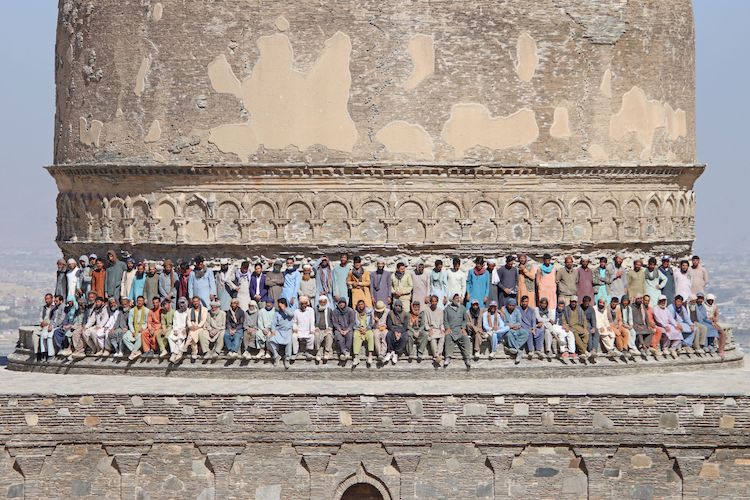 Workers at the restoration of the Shewaki Buddhist stupa near Kabul. Courtesy International Alliance for the Protection of Heritage in Conflict Areas (ALIPH).
Workers at the restoration of the Shewaki Buddhist stupa near Kabul. Courtesy International Alliance for the Protection of Heritage in Conflict Areas (ALIPH). 

